Yaesu Musen HX260S VHF HAND HELD RADIO TRANSMITTER User Manual OM supplement typeA HX260S
Yaesu Musen Co., Ltd. VHF HAND HELD RADIO TRANSMITTER OM supplement typeA HX260S
Contents
- 1. owners manual A
- 2. owners manual B
owners manual B
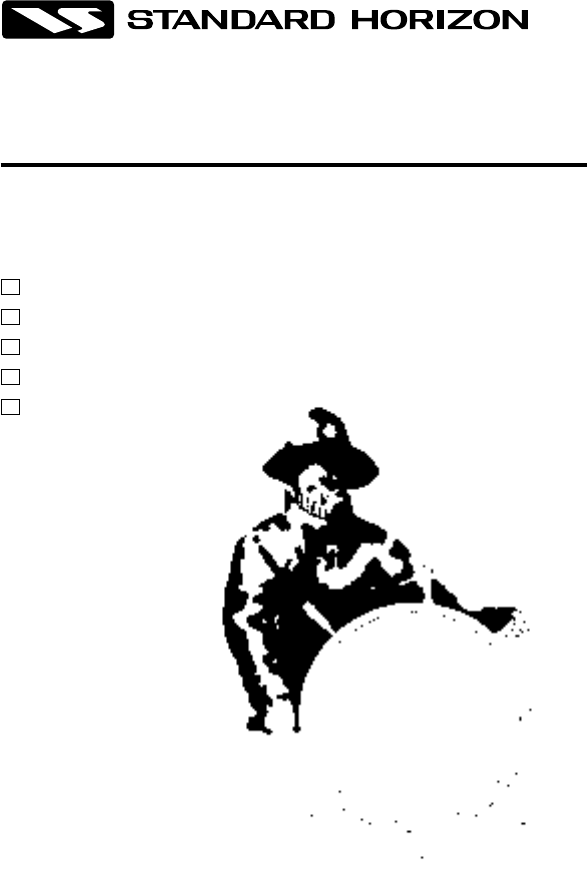
Owner’s Manual
Supplement
For Marine VHF Radios
Contains
FCC / INDUSTRY CANADA Information
Maintenance
Service
VHF Channel Charts
Warranty

page 1 Standard Horizon Marine Radios
NOTE
Please fill out the enclosed warranty registration postcard attached to the front
of this manual. Should the warranty registration postcard be missing, please
register on line at www.yaesu.com or contact Standard Horizon at:
17210 Edwards Road
Cerritos, CA 90703
FCC RADIO LICENSE INFORMATION
Standard Horizon radios comply with the Federal Communication Commission (FCC)
requirements that regulate the Maritime Radio Service.
Station License
An FCC ship station license is no longer required for any vessel traveling in U.S.
waters which uses a VHF marine radio, RADAR or EPIRB, and which is not required
to carry radio equipment. A license is necessary however for a DSC MMSI number,
any vessel required to carry a marine radio on an international voyage, carrying a HF
single side band radiotelephone or marine satellite terminal. FCC license forms,
including applications for ship (506) and land station licenses can be downloaded via
the Internet at www.fcc.gov/forms. To obtain a form from the FCC, call (888) 225-5322.
Radio Call sign
Currently the FCC does not require recreational boaters to have a Ship Radio Station
License. The USCG recommends the boats registration number and the state to be
used.
Canadian Ship Station Licensing
You do not need a license if your vessel is not operated in sovereign waters of a
country other than Canada or the U.S.A. If you do need a license contact their nearest
field office or regional office or write:
Industry Canada
Radio Regulatory Branch
Attn: DOSP
300 Slater Street
Ottawa, Ontario
Canada, KIA 0C8

Marine Radios Standard Horizon page 2
FACTORY SERVICE
In the unlikely event that the radio fails to perform or needs servicing, please contact
the following: Standard Horizon Factory Service
115 N. Wright Brothers Drive
Salt Lake City, UT 84116-2838
Telephone (800) 366-4566
Fax No. (801) 359-4122
WARRANTY INFORMATION CARD INSTRUCTIONS
THANK YOU for buying STANDARD HORIZON (a division of YAESU USA) products!
We are confident your new radio will serve your needs for many years!
Please complete the Owner’s Record below for your records. Then complete the
Warranty Information Card that should be attached to the front of this manual, detach
it and mail it to STANDARD HORIZON. Should you ever return the equipment to
your STANDARD HORIZON Dealer or to STANDARD HORIZON for in-warranty
repair, the Owner’s Record, or other proof of purchase, must be included with the
unit to provide warranty information.
In addition to the warranty, STANDARD HORIZON includes a lifetime “flat rate”
program to provide service after the warranty period has expired. If you wish to
obtain the flat rate price for out-of-warranty repair, you must include the information
on the Owner’s Record with the unit when you return it to your Dealer or to
STANDARD HORIZON.
Lifetime Flat Rate Service Program: For the original Owner only, for the lifetime of
the unit, STANDARD HORIZON will repair the unit to original specifications.
Note: The flat rate amount is payable by the Owner only if STANDARD HORIZON or
the STANDARD HORIZON Dealer determines that a repair is needed. After the repair,
a 90-day warranty will be in effect from the date of return of the unit to the Owner.
This service program is not available for equipment which has failed as a result of
neglect, accident, breakage, misuse, improper installation or modification, or water
damage. (depending on the product)
Model Serial Number
Purchase Date Dealer

page 3 Standard Horizon Marine Radios
OPERATING PRACTICES
Emergency (Channel 16 Use)
Channel 16 is known as the
Hail and Distress Channel
. An emergency may be
defined as a threat to life or property. In such instances, be sure the transceiver is on
and set to CHANNEL 16. Then use the following procedure:
1. Press the microphone push-to-talk switch and say “Mayday, Mayday, Mayday.
This is , , ” (your vessel's name).
2. Then repeat once: “
Mayday
, ,” (your vessel’s name).
3. Now report your position in latitude/longitude, or by giving a true or magnetic
bearing (state which) to a well-known landmark such as a navigation aid or
geographic feature such as an island or harbor entry.
4. Explain the nature of your distress (sinking, collision, aground, fire, heart
attack, life-threatening injury, etc.).
5. State the kind of assistance your desire (pumps, medical aid, etc.).
6. Report the number of persons aboard and condition of any injured.
7. Estimate the present seaworthiness and condition of your vessel.
8. Give your vessel's description: length, design (power or sail), color and other
distinguishing marks. The total transmission should not exceed 1 minute.
9. End the message by saying
“OVER”
. Release the microphone button and
listen.
10. If there is no answer, repeat the above procedure. If there is still no response,
try another channel.
Calling Another Vessel (Channel 16 or 9)
Channel 16 may be used for initial contact (hailing) with another vessel. However, its
most important use is for emergency messages. This channel must be monitored at
all times except when actually using another channel. It is monitored by the U.S. and
Canadian Coast Guards and by other vessels. Use of channel 16 for hailing must
be limited to initial contact only. Calling should not exceed 30 seconds, but may
be repeated 3 times at 2-minute intervals. In areas of heavy radio traffic, congestion
on channel 16 resulting from its use as a hailing channel can be reduced significantly
in U.S. waters by using channel 9 as the initial contact (hailing) channel for non-
emergency communications. Here, also, calling time should not exceed 30 seconds
but may be repeated 3 times at 2-minute intervals.
Prior to making contact with another vessel, refer to the channel charts in this
manual, and select an appropriate channel for communications after initial contact.

Marine Radios Standard Horizon page 4
For example, Channels 68 and 69 of the U.S. VHF Charts are some of the channels
available to non-commercial (recreational) boaters. Monitor your desired channel in
advance to make sure you will not be interrupting other traffic, and then go back to
either channel 16 or 9 for your initial contact.
When the hailing channel (16 or 9) is clear, state the name of the other vessel you
wish to call and then
“this is”
followed by the name of your vessel and your Station
License (Call Sign). When the other vessel returns your call, immediately request
another channel by saying
“go to”
, the number of the other channel, and "over."
Then switch to the new channel. When the new channel is not busy, call the other
vessel.
After a transmission, say
“over”
, and release the microphone's push-to-talk (PTT)
switch. When all communication with the other vessel is completed, end the last
transmission by stating your Call Sign and the word
“out”
. Note that it is not
necessary to state your Call Sign with each transmission, only at the beginning and
end of the contact.
Remember to return to Channel 16 when not using another channel. Some radios
automatically monitor Channel 16 even when set to other channels or when
scanning; see your Owner's Manual.
Making Telephone Calls
To make a radiotelephone call, use a channel designated for this purpose, The
fastest way to learn which channels are used for radiotelephone traffic is to ask at a
local marina. Channels available for such traffic are designated
Public
Correspondence
channels on the channel charts in this manual. Some examples
for USA use are Channels 24, 25, 26, 27, 28, 84, 85, 86, and 87. Call the marine
operator and identify yourself by your vessel's name, The marine operator will then
ask you how you will pay for the call (telephone credit card, collect, etc.) and then link
your radio transmission to the telephone lines.
The marine telephone company managing the VHF channel you are using may
charge a link-up fee in addition to the cost of the call.
Operating On Channels 13 And 67
Channel 13 is used at docks and bridges and by vessels maneuvering in port.
Messages on this channel must concern navigation only, such as meeting and
passing in restricted waters.
Channel 67 is used for navigational traffic between vessels.
By regulation, power is normally limited to 1 Watt on these channels. Your radio is
programmed to automatically reduce power to this limit on these channels. However,
in certain situations it may be necessary to temporarily use a higher power. See your
Owner's Manual for means to temporarily override the low-power limit on these two
channels.

page 5 Standard Horizon Marine Radios
Prohibited Communications
The FCC prohibits the following communications:
nFalse distress or emergency messages:
nMessages to "any boat" except in emergencies and radio tests;
nMessages to or from a vessel on land;
nTransmission while on land;
nObscene, indecent, or profane language (potential fine of $10,000).
NOAA Weather Alert Testing
In the event of a major storm or other appreciable weather condition requiring
vessels at sea or other bodies of water to be notified, the NOAA (National
Oceanographic and Atmospheric Administration) broadcasts a 1050 Hz tone that
some marine VHF radios can detect. (Refer to your radio's Owner's Manual on how
to use this feature.) This tone, when detected, will produce a loud beep from the
radio speaker to signal that a weather alert is being broadcast.
In order to test this system, the NOAA broadcasts the 1050 Hz tone every
Wednesday, sometime between 11 AM and 1 PM. Any marine VHF radio that can
detect the weather alert tone, may use this test to verify that this feature is
functioning properly,

Marine Radios Standard Horizon page 6
Digital Selective Calling (DSC)
Digital Selective Calling is a semi-automated method of establishing a radio call, it
has been designated by the International Maritime Organization (IMO) as an
international standard for establishing VHF, MF and HF radio calls. It has also been
designated part of the Global Maritime Distress and Safety System (GMDSS) and it
is planned that DSC will eventually replace aural watches on distress frequencies
and will be used to announce routine and urgent maritime safety information
broadcasts.
This new service will allow mariners to instantly send a distress call with GPS position
(when connected to the transceiver) to the US Coast Guard and other vessels within
range of the transmission. DSC will also allow mariners to initiate or receive distress,
urgency, safety and routine calls to or from another vessel equipped with a DSC
transceiver.
USCG DSC Watch
The USCG has plans to upgrade its VHF National Distress System (expected by
2005), so at the time of printing only larger vessels that are required to carry VHF
DSC radios will be able to hear your distress transmission
Maritime Mobile Service Identity(MMSI)
What is a MMSI?
A MMSI is a nine digit number used on Marine Transceivers capable of using Digital
Selective Calling (DSC). This number is used like a telephone number to selectively
call other vessels.
How can I obtain a MMSI assignment?
At the time of this printing, to obtain an MMSI the user must contact the FCC and
apply for a Ship Station License form 506, or an amendment to a ship station license,
regardless of whether the license is otherwise required. This procedure is currently
under review by both the FCC and US Coast Guard. Refer to FCC ship station license
section for contact information.
Using Digital Selective Calling Features
Distress Call
Transmits a DSC Distress message to all radios equipped to receive a DSC Distress
call. Some Standard Horizon radios may be connected to a GPS to also transmit the
Latitude, Longitude of the vessel.

page 7 Standard Horizon Marine Radios
Individual Call
This feature allows the user to contact another vessel capable of using DSC to
automatically switch the radio to a desired working channel. This feature is similar to
calling a desired vessel on CH16 and requesting them to go to another channel.
Urgency Call
This call should be used when a vessel may not be truly in distress, but have a
potential problem that might lead to a distress situation.
Safety Call
Used to transmit boating safety information to other vessels. This message usually
contains information about an overdue boat, a derelict afloat, loss of a navigation aid
or an important meteorological message.
Position request
Used to poll vessels position via DSC and show it on the LCD of the radio.
ADDITIONAL DIGITAL SELECTIVE CALLING
INFORMATION
For additional information the USCG has an excellent site that should be visited at
www.navcen.uscg.mil/marcoms/gmdss/dsc.html
About VHF Radio
The radio frequencies used in the VHF marine band lie between 156 and 158 MHz
with some shore stations available between 161 and 163MHz. The marine VHF band
provides communications over distances that are essentially “line of sight” (VHF signals
do not travel well through objects such as buildings, hills or trees). Actual transmission
range depends much more on antenna type, gain and height than on the power
output of the transmitter. On a fixed mount 25W radio transmission expected distances
can be greater than 15 miles, for a portable 5W radio transmission the expected
distance can be greater than 5 miles in “line of sight”.
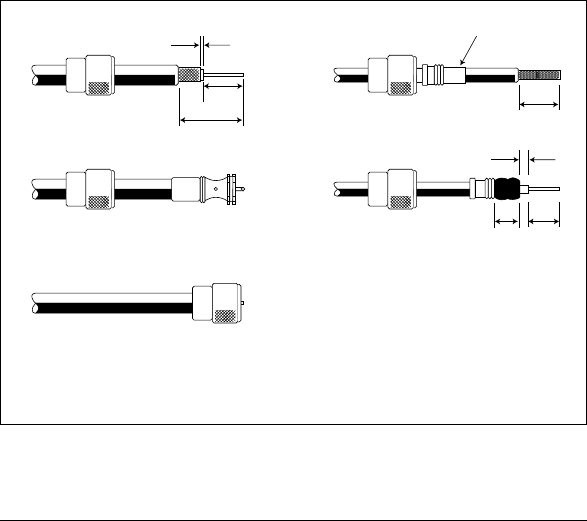
Marine Radios Standard Horizon page 8
Selecting an Antenna
Marine antennas are made to radiate signals equally in all horizontal directions, but
not straight up. The objective of a marine antenna is to enhance the signal toward the
horizon. The degree to which this is accomplished is called the antenna’s gain. It is
measured in decibels (dB) and is one of the major factors in choosing an antenna. In
terms of effective radiated power (ERP), antennas are rated on the basis of how
much gain they have over a theoretical antenna with zero gain. A 3 foot, 3dB gain
antenna represents twice as much gain over the imaginary antenna. The length of
the antenna you choose, however, must also be related to the size of your boat.
Typically a 3 foot 3dB gain stainless steel whip is used on a sailboat mast. The longer
8 foot 6dB is primarily used on power boats that require the additional gain.
Coaxial Cable
VHF antennas are connected to the transceiver by means of a coaxial cable – a
shielded transmission line. Coaxial cable is specified by it’s diameter and construction.
For runs less than 20 feet, RG-58/U, about 1/4 inch in diameter is a good choice. For
runs over 20 feet, the larger RG-8U or RG-213/U should be used. For installation of
the connector onto the coaxial cable refer to the figure below.
To get your coax cable through a fitting and into your boat's interior, you may have
to cut off the end plug and reattach it later. You can do this if you follow the directions
that come with the connector. Be sure to make good soldered connections.
1/16''
3/4'' 3/4''
1 1/8''
1/8''
5/8''3/8''
Adapter

page 9 Standard Horizon Marine Radios
MAINTENANCE
General
The inherent quality of the solid-state components in STANDARD HORIZON radios
will provide many years of continuous use. Take the following precautions to prevent
damage to the radio.
nKeep the microphone connected or the jack covered at all times to prevent
corrosion of electrical contacts;
nNever key the transmitter unless an antenna or suitable dummy load is
connected to the antenna receptacle;
nEnsure that the input voltage does not exceed the value specified in your
Owner's Manual;
nUse only STANDARD HORIZON-approved accessories and replacement parts.
Batteries and Chargers
CAUTION
This section is applicable only for radios with external battery packs.
Battery Maintenance
For safe and proper battery use, please observe the following:
nBattery packs should be charged only in non-hazardous environments;
nUse only STANDARD HORIZON-approved batteries;
nUse only a STANDARD HORIZON, (a division of YAESU USA) approved
charger. The use of any other charger may cause permanent damage to the
battery;
nFollow charging instructions provided with the chargers;
nDo not use the radio while it is in the charger;
nKeep the battery contacts clean.
Battery Storage
Store batteries in a cool place to maximize storage life. Since batteries are subject to
self-discharge, avoid high storage temperatures that cause large self-discharge
rates. After extended storage, a full recharge is recommended.

Marine Radios Standard Horizon page 10
Memory Cycling
Partially discharging a nickel-cadmium battery and then recharging it causes a
phenomenon called "memory". When a battery establishes a memory, its available
capacity is reduced, To ensure that a nickel-cadmium battery pack retains its full
capacity, the battery pack should be almost fully discharged and then recharged
completely after every few cycles of use.
Battery Recycling
DO NOT PLACE USED BATTERIES IN YOUR
REGULAR TRASH!
NICKEL-CADMIUM BATTERIES MUST BE
COLLECTED, RECYCLED OR DISPOSED OF IN
AN ENVIRONMENTALLY SOUND MANNER.
The incineration, landfilling or mixing of nickel-cadmium batteries with the municipal
solid waste stream is PROHIBITED BY LAW in most areas.
Return batteries to an approved nickel-cadmium battery recycler. This may be where
you purchased the battery.
Contact your local waste management officials for other information regarding the
environmentally sound collection, recycling and disposal of nickel-cadmium
batteries.

page 11 Standard Horizon Marine Radios
CHANNEL ASSIGNMENTS
Tables on the following columns list the VHF Marine Channel assignments for
U.S.A. and International use. Below are listed some data about the charts.
1. VTS. Where indicated, these channels are part of the U.S. Coast Guard’s Vessel
Traffic System.
2. Alpha channel numbers, that is, channel numbers followed by the letter A (such
as Channel 07A) are
simplex
channels on the U.S.A. or Canadian channel
assignments whose counterparts in the International assignments are
duplex
channels. International channels do not use “alpha” numbers. If you call the Coast
Guard on Channel 16, they will sometimes ask you to
“go to channel 22 Alpha.”
This is a channel assigned to U.S.A, and Canadian Coast Guards for handling
distress and other calls. If your radio is set for
International
operation you will go to
Channel 22 instead of 22A, and will not be able to communicate with the Coast
Guard. To use Channel 22A, your radio must be set for
USA
or
Canada
operation,
usually by a U/I/C (USA/International/Canada) control or combination of controls
(see your Owner’s Manual). Channel 22 (without an “A”) is an
International
duplex
channel for port operations. Some radios indicate an “A” adjacent to the alpha
channels on the display; on others “alpha” is not indicated but the proper channel is
selected based on the U/I/C setting.
3. Bridge-to-Bridge channels (for example, Channel 13) are for use by bridge
operators on intercoastal waterways and rivers. It is also used by marine vessels in
the vicinity of these bridges for navigation and for communicating with the bridge
operators.
Note that a limit of 1 Watt is specified for these channels.
See page
4 for additional information.
4. The
S/D
column on the chart indicates either S (simplex) or D (duplex).
Simplex
means transmitting and receiving on the same frequency. Only one party at a time
can talk, unlike a telephone. Be sure to say
“over”
and release your microphone
push-to-talk switch at the end of each transmission.
Duplex
operation involves the
use of one frequency for transmitting and a separate frequency for receiving. On
channels specified as duplex on the charts, correct mode of operation is established
automatically by your radio when you select a channel; you cannot change the
mode. And you still must release the push-to-talk switch after each transmission in
order to listen to the radio.
5. Channels normally used by recreational boaters are those that include the term
“non-commercial” in the
Channel Use
column of the chart. Some of these are
shared with other users and some are used only in certain geographic regions.
6. Marine vessels equipped with VHF radios are required to monitor Channel
16. For some radios, this is done automatically when the radio is on; see your
Owner’s Manual.
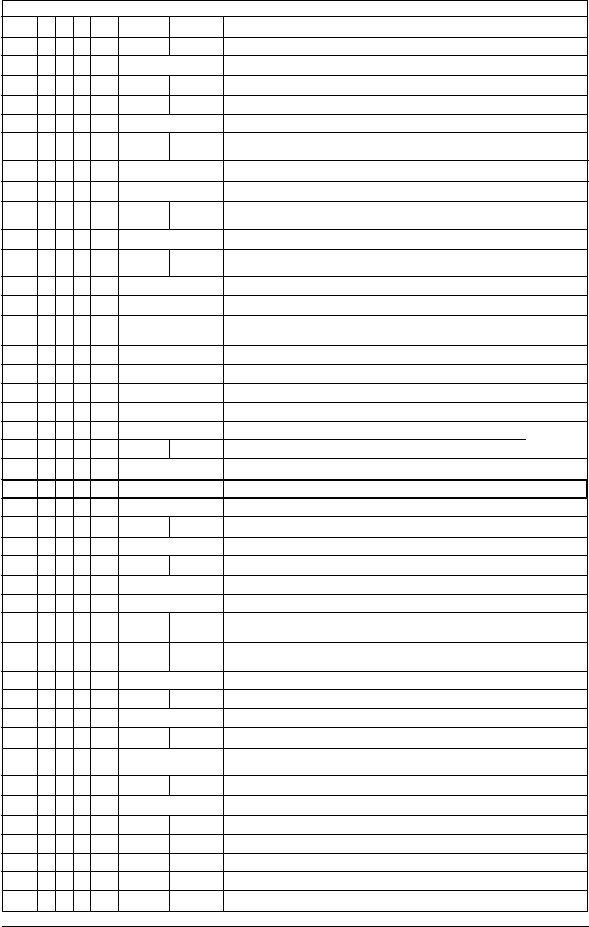
Marine Radios Standard Horizon page 12
VHF MARINE CHANNEL CHART
CH U C I S/D TX RX CHANNEL USE
01 X X D 156.050 160.650 Public Correspondence (Marine Operator)
01A X S 156.050 Port Operation and Commercial. VTS in selected areas
02 X X D 156.100 160.700 Public Correspondence (Marine Operator)
03 X X D 156.150 160.750 Public Correspondence (Marine Operator)
03A X S 156.150 US Government only, Coast Guard
04 X D 156.200 160.800
Public Correspondence (Marine Operator), Port operation, ship
movement
04A X S 156.200 Pacific coast: Coast Guard, East Coast: Commercial fishing
05A X X S 156.250 Port operation. VTS in Seattle.
05 X D 156.250 160.850 Public Correspondence (Marine Operator), Port operation, ship
movement
06 X X X S 156.300 Inter-ship Safety
07 X D 156.350 160.950 Public Correspondence (Marine Operator), Port operation, ship
movement
07A X X S 156.350 Commercial
08 X X X S 156.400 Commercial (Inter-ship only)
09 X X X S 156.450 Boater Calling channel, Commercial & Non-commercial
(Recreational)
10 X X X S 156.500 Commercial
11 X X X S 156.550 Commercial. VTS in selected areas.
12 X X X S 156.600 Port operation. VTS in selected areas.
13 X X X S 156.650 Inter-ship Navigation Safety (Bridge-to-bridge)
14 X X X S 156.700 Port operation. VTS in selected areas.
15 X S --- 156.750 Environmental (Receive only)
15 X X S 156.750 Commercial, non-commercial, ship movement (1W)
16 X X X S 156.800 International Distress, Safety and Calling.
17 X X X S 156.850 State Controlled (1 W)
18 X D 156.900 161.500 Port operation, ship movement
18A X X S 156.900 Commercial
19 X D 156.950 161.550 Port operation, ship movement
19A X S 156.950 US: Commercial
19A X S 156.950 Coast Guard
20 X X D 157.000 161.600 Canadian Coast Guard Only, International: port operations and
shipment
20 X D 157.000 161.600 Canadian Coast Guard Only, International: port operations and
shipment (1 W)
20A X S 157.000 Port Operation
21 X D 157.050 161.650 Port operation, ship movement
21A X X S 157.050 U.S. Government Only, Canadian Coast Guard
22 X D 157.100 161.700 Port operation, ship movement
22A X X S 157.100 US and Canadian Coast Guard Liaison and Maritime Safety
Information Broadcasts announced on channel 16
23 X X D 157.150 161.750 Public Correspondence (Marine Operator)
23A X S 157.150 U.S. Government Only
24 X X X D 157.200 161.800 Public Correspondence (Marine Operator)
25 X X X D 157.250 161.850 Public Correspondence (Marine Operator)
26 X X X D 157.300 161.900 Public Correspondence (Marine Operator)
27 X X X D 157.350 161.950 Public Correspondence (Marine Operator)
28 X X X D 157.400 162.000 Public Correspondence (Marine Operator)
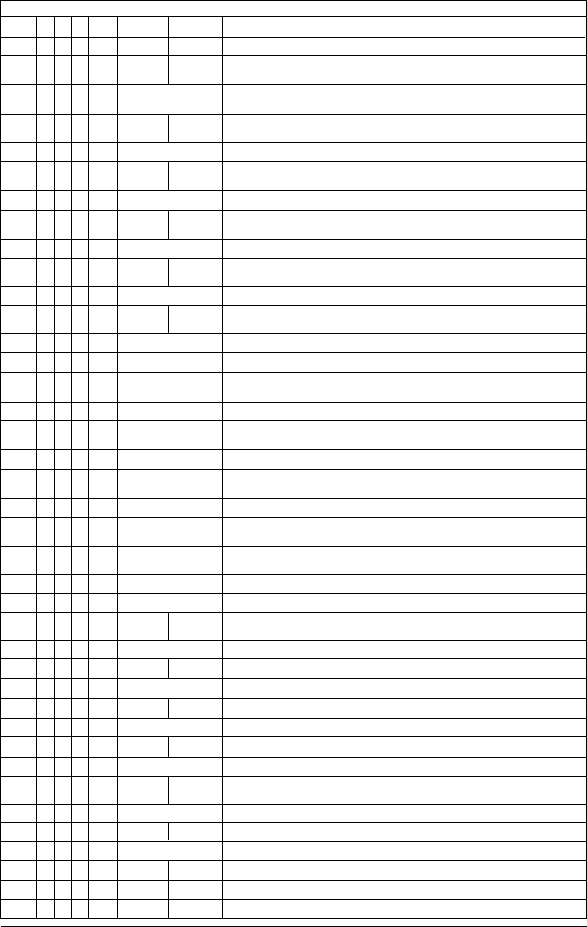
page 13 Standard Horizon Marine Radios
VHF MARINE CHANNEL CHART
CH U C I S/D TX RX CHANNEL USE
60 X X D 156.025 160.625 Public Correspondence (Marine Operator)
61 X D 156.075 160.675 Public Correspondence (Marine Operator), Port operation, ship
movement
61A X X S 156.075 U.S. Government Only, Canadian Coast Guard-Pacific
Coast, Commercial Fishing-East Coast
62 X D 156.125 160.725 Public Correspondence (Marine Operator), Port operation, ship
movement
62A X S 156.125 Pacific Coast: Coast Guard; East Coast: commercial fishing only
63 X D 156.175 160.775 Public Correspondence (Marine Operator), Port operation, ship
movement
63A X S 156.175 Port Operation and Commercial. VTS in selected areas.
64 X X D 156.225 160.825 Public Correspondence (Marine Operator), Port operation, ship
movement
64A X X S 156.225 U.S. Government Only, Canadian Commercial Fishing
65 X D 156.275 160.875 Public Correspondence (Marine Operator), Port operation, ship
movement
65A X X S 156.275 Port Operations
66 X D 156.325 160.925 Public Correspondence (Marine Operator), Port operation, ship
movement
66A X S 156.325 Port Operations
66A X S 156.325 Port Operations (1W)
67 X X X S 156.375
US: Commercial. Used for Bridge-to-bridge communications in lower
Mississippi River. Inter-ship only, Canada: Commercial fishing, S&R
68 X X X S 156.425 Non-commercial (Recreational)
69 X X X S 156.475 US: Non-commercial (Recreational), Canada: Commercial
fishing only. International: Port operations and Ship movement
70 X X X S 156.525 Digital selective calling (voice communications not allowed)
71 X X X S 156.575 US, Canada: Non-commercial (Recreational),International: Port
operations and Ship movement
72 X X X S 156.625 Non-commercial (Inter-ship only)
73 X X X S 156.675 US: Port Operations, Canada: Commercial fishing only,
International: Inter-ship, Port operations and Ship movement
74 X X X S 156.725 US: Port Operations, Canada: Commercial fishing only,
International: Inter-ship, Port operations and Ship movement
77 X X S 156.875 Port Operations (inter-ship only) (1 W)
77 X S 156.875 Port Operations (inter-ship only)
78 X D 156.925 161.525 Public Correspondence (Marine Operator), Port operation, ship
movement
78A X X S 156.925 Non-commercial(Recreational)
79 X D 156.975 161.575 Port operation and Ship movement
79A X X S 156.975 Commercial
80 X D 157.025 161.625 Port operation, ship movement
80A X X S 157.025 Commercial
81 X D 157.075 161.675 Port operation, ship movement
81A X X S 157.075 U.S. Government Only – Environmental protection operations.
82 X D 157.125 161.725 Public Correspondence (Marine Operator), Port operation, ship
movement
82A X X S 157.125 U.S. Government Only, Canadian Coast Guard Only
83 X D 157.175 161.775 Canadian Coast Guard Only
83A X X S 157.175 U.S. Government Only, Canadian Coast Guard Only
83 X D 157.175 161.775 Public Correspondence (Marine Operator)
84 X X X D 157.225 161.825 Public correspondence (Marine Operator)
85 X X X D 157.275 161.875 Public correspondence (Marine Operator)

Marine Radios Standard Horizon page 14
VHF MARINE CHANNEL CHART
CH U C I S/D TX RX CHANNEL USE
86 X X X D 157.325 161.925 Public correspondence (Marine Operator)
87 X X X D 157.375 161.975 Public correspondence (Marine Operator)
88 X X X D 157.425 162.025 Public correspondence (ship-to-coast)
88A X S 157.425 Commercial, Inter-ship Only
WX01 X X X D --- 162.550 Weather (receive only)
WX02 X X X D --- 162.400 Weather (receive only)
WX03 X X X D --- 162.475 Weather (receive only)
WX04 X X X D --- 162.425 Weather (receive only)
WX05 X X X D --- 162.450 Weather (receive only)
WX06 X X X D --- 162.500 Weather (receive only)
WX07 X X X D --- 162.525 Weather (receive only)
WX08 X X X D --- 161.650 Weather (receive only)
WX09 X X X D --- 161.775 Weather (receive only)
WX10 X X X D --- 163.275 Weather (receive only)
The BOLD channels above are not for use by the general public in US water, unless
proper authorization is given.

page 15 Standard Horizon Marine Radios
WARRANTY
Marine Products Limited Warranty
STANDARD HORIZON (a division of YAESU USA) warrants, to the original purchaser
only, each new Marine Communications Product ("Product") manufactured and/or
supplied by STANDARD HORIZON against defects in materials and workmanship
under normal use and service for a period of time from the date of purchase as follows:
Fixed Mount and Portable Transceivers
1 year - if purchased before 01/01/91
3 years - if purchased between 01/01/91 and 01/01/94
3 years Waterproof - if purchased after 01/01/94
Loud hailers
1 year - if purchased before 01/01/91
3 years - if purchased after 01/01/91
Associated Chargers
1 year - if purchased before 01/01/91
3 years - if purchased after 01/01/91
Associated Batteries - 18 months. Note: Batteries will be deemed deflective only if
storage capacity drops below 80% of rated capacity or if leakage develops.
Associated Accessories- 1 year. Includes: Microphones/Handsets, External
Speakers, Antennas, Carrying Accessories, Power Supplies, and Signaling Boards.
To receive warranty service, the purchaser must deliver the Product, transportation
and insurance prepaid, to STANDARD HORIZON (a division of YAESU USA)., 115
North Wright Brothers Dr, Salt Lake City, Utah 84116-2838. Include proof of
purchase indicating model. serial number, and date of purchase. STANDARD
HORIZON will return the Product to the purchaser freight prepaid. Products
purchased prior to January 1, 1991 will bear the STANDARD HORIZON warranty
terms in effect prior to that date.
In the event of a defect, malfunction or failure of the Product during the warranty period,
STANDARD HORIZON's liability for any breach of contract or any breach of express or
implied warranties in connection with the sale of Products shall be limited solely to repair
or replacement, at its option, of the Product or part(s) therein which, upon examination by
STANDARD HORIZON, appear to be defective or not up to factory specifications.
STANDARD HORIZON may, at its option, repair or replace parts or subassemblies with
new or reconditioned parts and subassemblies. Parts thus repaired or replaced are
warranted for the balance of the original applicable warranty.

Marine Radios Standard Horizon page 16
STANDARD HORIZON will not warrant installation, maintenance or service of the
Products. In all instances, STANDARD HORIZON's liability for damages shall not
exceed the purchase price of the defective Product. This warranty only extends to
Products sold within the 50 States of the United States of America and the District of
Columbia.
STANDARD HORIZON will pay all labor to repair the product and replacement parts
charges incurred in providing the warranty service except where purchaser abuse or
other qualifying exceptions exist. The purchaser must pay any transportation
expenses incurred in returning the Product to STANDARD HORIZON for service.
This limited warranty does not extend to any Product which has been subjected to
misuse, neglect, accident, incorrect wiring by anyone other than STANDARD
HORIZON, improper installation, or subjected to use in violation of instructions
furnished by STANDARD HORIZON, nor does this warranty extend to Products on
which the serial number has been removed, defaced, or changed. STANDARD
HORIZON cannot be responsible in any way for ancillary equipment not furnished by
STANDARD HORIZON which is attached to or used in connection with STANDARD
HORIZON’s Products, or for the operation of the Product with any ancillary
equipment, and all such equipment is expressly excluded from this warranty.
STANDARD HORIZON disclaims liability for range, coverage, or operation of the
Product and ancillary equipment as a whole under this warranty. STANDARD
HORIZON reserves the right to make changes or improvements in Products, during
subsequent production, without incurring the obligation to install such changes or
improvements on previously manufactured Products.
The implied warranties which the law imposes on the sale of this Product are
expressly LIMITED, in duration, to the time period specified above. STANDARD
HORIZON shall not be liable under any circumstances for consequential damages
resulting from the use and operation of this Product, or from the breach of this
LIMITED WARRANTY, any implied warranties, or any contract with STANDARD
HORIZON. IN CONNECTION WITH THE SALE OF ITS PRODUCTS, STANDARD
HORIZON MAKES NO WARRANTIES, EXPRESS OR IMPLIED AS TO THE
MERCHANTABILITY OR FITNESS FOR A PARTICULAR PURPOSE OR
OTHERWISE, EXCEPT AS EXPRESSLY SET FORTH HEREIN.
Some states do not allow the exclusion or limitation of incidental or consequential
damages, or limitation on how long an implied warranty lasts, so the above
limitations or exclusions may not apply. This warranty gives specific legal rights, and
there may be other rights which may vary from state to state.
ONLY PRODUCTS SOLD ON OR AFTER JANUARY 1, 1991 ARE COVERED
UNDER THE TERMS OF THIS LIMITED WARRANTY.
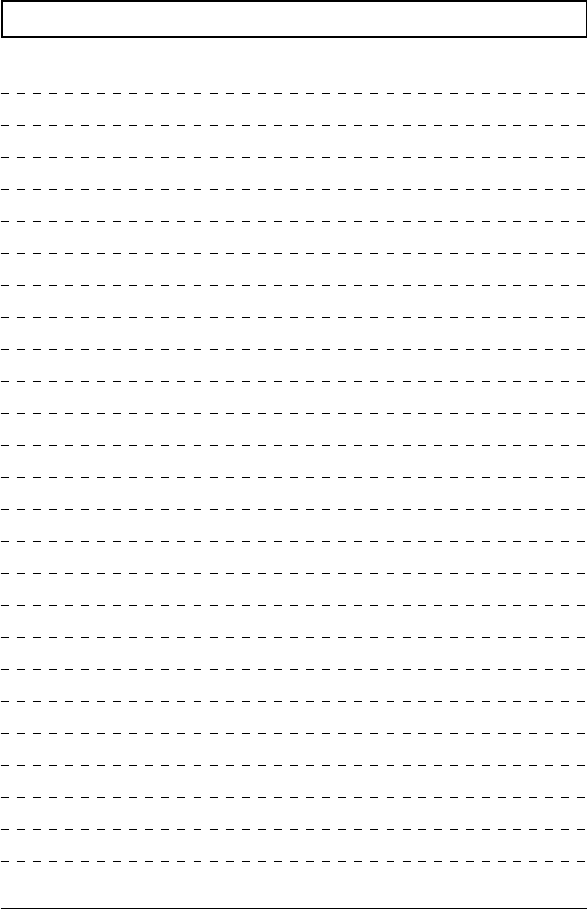
page 17 Standard Horizon Marine Radios
MEMO

YAESU U. S. A.
17210 Edwards Rd., Cerritos, CA 90703, U.S.A.
Printed in China
07/00 451X851020
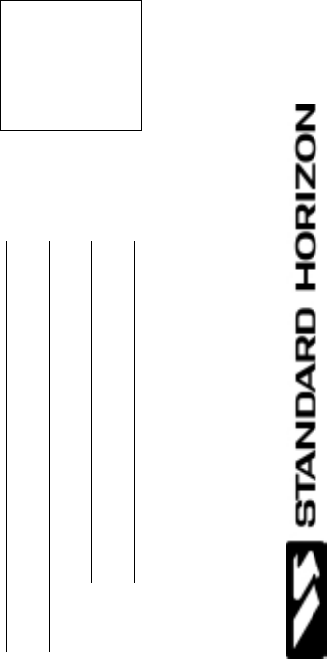
Name:
Street:
City/State:
Zip Code:
Marine Division Of Yaesu U.S.A.
17210 Edwards Road
Cerritos, CA 90703
Place
Stamp
Here

Thank you for Purchasing a Standard Horizon Product!
Fill out the front & back of this card, or register on line
at www.yaesu.com.
Date Purchased: Model No:
Email:
Serial No:
Dealer Purchased From:
Type of Boat?
Feature desired in product?
Next Electronic Purchase?
How did you hear about Standard Horizon?
Power Sail Commercial
VHF Handheld Radio
GPS/GPS Chart Plotter
Autopilot
VHF Fixed Mount Radio
Fishfinder
Dealer
Previous Purchase
Internet Search Engine: Other:
Friend
Magazine/Newspaper
Direct Mail
Other:
Stereo CD Player Depth Sounder
Size?
When?
Ft
Days